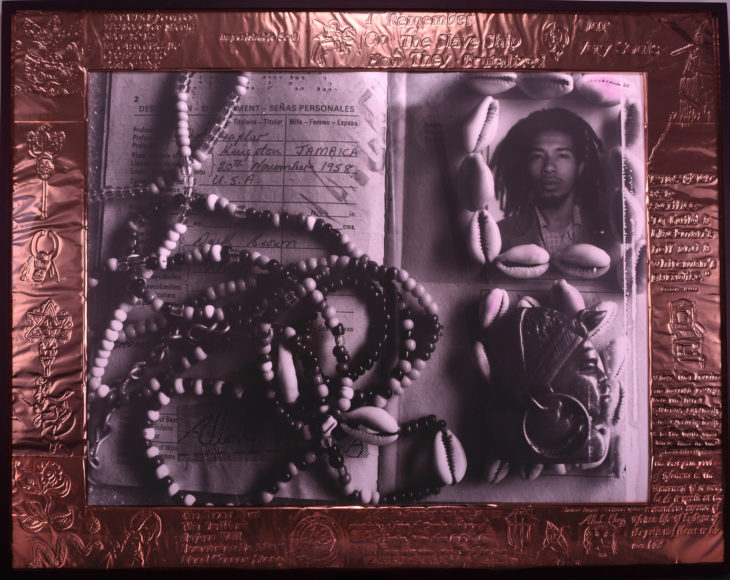Student Essay: Alice Zhao on ‘No Ocean Between Us’
September 13, 2021
Our summer CURF intern, Alice Zhao, worked closely with Heather Moqtaderi, Assistant Director and Curator, on preparing for the upcoming exhibition No Ocean Between Us: Art of Asian Diasporas in Latin American & the Caribbean, 1940-Present. In this essay, Alice reflects on researching two artists of Afro-Chinese descent.
The Arthur Ross Gallery’s Winter 2022 exhibition No Ocean Between Us: Art of Asian Diasporas in Latin America & the Caribbean, 1940-Present, highlights contemporary artists of the Asian Diaspora in Latin America, and the vastly undocumented and overlooked history of Asian migration and indentured servitude in the region. As a Chinese national and a first-generation immigrant to the U.S., I am thrilled to work on an exhibition that brings visibility to artists who carry multiple cultural identities.

Two of the most well-known artists in our exhibition are the Afro-Chinese Cuban Wifredo Lam (1902-82) and the Afro-Chinese Jamaican Albert Chong (b. 1958). Lam’s mother was of African, Spanish, and Taíno descent. His father was the son a Chinese immigrant, and grew up during Cuba’s “coolie trade” following the country’s supposed abolition of slavery. At the time, Chinese coolies were obtained cheaply as indentured servants but in fact used as slaves on sugarcane plantations. Albert Chong was born to a family of Afro-Chinese Jamaican merchants, and both his parents had a Chinese father and an Afro-Jamaican mother.
Although both men are of Afro-Chinese descent, I was struck to learn that they are most known for African influence on their art. While No Ocean Between Us uses identity-based inclusion, the strategy seems paradoxical due to the difficulty of tracing Lam and Chong’s engagement with their Asian backgrounds. From a personal perspective, seeing both men acclaimed predominantly for their contributions to African art makes me feel slightly distanced from their statures, as their Chinese identities remain obscured. Why, for example, is Lam frequently labeled as an Afro-Cuban artist with no acknowledgment of his Chinese heritage? Was this caused by the inattention of art scholars, or did Lam and Chong purposefully sidestep their Chinese identities? Unearthing their Asian influence has become a crucially important task for me.
My research this summer provided me with more clarity. With regards to Lam’s borrowings from Chinese art, University of Maryland Professor Abigail McEwen mentioned that the tonality of ink wash painting, stylistic harmony, refinement, and spirituality in his work all reflect his familiarity with Chinese culture. Meanwhile, UCLA professor Sean Metzger argued that the integration of pre-modern Chinese elements into Lam’s style confines “Chineseness” to the realm of the traditional, and pointed out that “Chineseness” might also be exhibited through modern experiences of dislocation stemmed from Cuba’s coolie trade.

In historical terms, the Chinese ethnic identity often existed outside of Cuban and Jamaican societies’ frameworks of racial categorization. Lam’s generation of mixed-race Afro-Chinese Cubans were often classified as mestizo, pardo, or libre de color, all of which often signified only African heritage. Meanwhile, as Albert Chong mentioned in his interview, the terms that exist to determine Jamaica’s ethnic hybridity aimed solely to account for the decrease in whiteness instead of Afro-Chinese miscegenation. Individually, neither Lam nor Chong was taught Chinese, which presented an obvious obstacle to fully accessing the culture. There may well also have been danger in openly identifying as Chinese in their respective societies. In Lam’s Cuba, the importation of Chinese coolies burdened Chinese men with enduring tropes of being foreign, exotic, and bachelors. Still, I find myself wondering if Lam would have striven to better access his Chinese heritage had his father not passed away when he was young. Chong mentions that his experience of being Chinese in Jamaica consisted of being called names as a teenager, hearing the song “Black Chiney Men” (which denoted the racial tension between Chinese and Afro-Jamaicans), and witnessing the burning of Chinese businesses in Kingston. If there had been a flourishing Asian-American art community when Chong migrated to New York in the late 70s, I wonder if he would have chosen to be part of it.
Through learning about these artists as individuals, I have recognized my own earlier mistake in positioning Chong and Lam in a clear-cut category of Asian art. By doing so, I have unconsciously fallen into Western museums’ historical tendency to identify and distinguish art made by the “other”. As much as I desire the representation of Asian artists from these men, I have come to recognize that my desire might further constrain them from artistic acknowledgment beyond their identities.
Thus, instead of tracking down Lam and Chong’s “Chineseness”, there may be a better set of questions to pose: How can we curate this exhibition without making identity-based analyses the chief mode of engagement? How can we invite viewers to examine these extraordinary bodies of work through multifaceted lenses? Finally, by featuring these artists, how can we honor and bring visibility to the generations of communities that supported and paved the way for them? As a returning Gallery Intern at Arthur Ross this fall, I look forward to engaging with these questions and participating in discussions pertaining to the content of No Ocean Between Us.